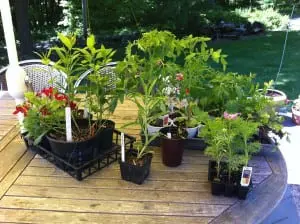By Pamela Doan
Good soil prep in the vegetable garden before planting will make the growing season less work and create a more bountiful harvest. For every 1 percent of organic matter that is added to the soil, gardeners can reap a 12 percent return when it’s time to pick crops. (If only that same principle applied to our savings accounts.) Given those odds, taking the time to top-dress the garden with compost is worth it.

Garden soil doesn’t need to be tilled. In fact, tearing up the ground with a rototiller or shovel has the detrimental effect of disrupting and destroying the microbe communities that benefit plants. Save your energy and simply add an inch or two of compost on top and plant seeds or transplants directly into it. The nutrients will be there for the plant either way.
Most vegetables like a pH level of 6.0 to 6.5. Even if a soil test shows your garden is at that ideal level, organic matter should be added annually to return nutrients that the plants took out the year before. Fertilizer and organic matter won’t adjust the pH level, though.
If the soil is too acidic with a pH level of 4.5 to 5.5, it can be improved with limestone. This is a powdery substance that should be applied two to three months before planting for best absorption. Alkaline soils have a pH above 7.5 and can be adjusted with sulfur to lower the pH level. Follow the formula on the bag about how much to apply per square foot.
Rotating planting is one other trick to maximizing soil health. Try to avoid putting plants from the same family in the same place in the garden. An easy system is to divide the garden into four sections and keep a garden journal noting the location of plants from year to year. Move them from one section to another every year so that they don’t come back to their original spot for four years.
Since different types of vegetables take different types of nutrients from the soil, this technique will keep the soil healthier. It also can help avoid diseases and pests that may over-winter in the soil from coming back the next season and finding their host.
I want to grow organic vegetables, is there anything I can add to boost the soil nutrient level that isn’t a chemical?
Organic growers have options that are sold at landscape centers or can be found online. There are mixes made from organic materials that are specific for certain types of plants and then single ingredient fertilizers like kelp or bone meal that can be added to the soil to boost growth during the growing season for heavy-feeding plants like tomatoes.
If you’re also a vegan, check the ingredients on a bag because some are made with fish products and bone meal and blood meal are made from animals. Well-aged manure from plant-eating animals will add nutrients; dairy cow, sheep or goat manure are good choices. Horse manure has a lot of weed seeds in it.
Planting cover crops including buckwheat, winter rye and winter wheat enhance soil naturally in an organic garden, lessen erosion, and improve porosity. You can’t go wrong using this natural technique.
I add compost to the garden every year. Does it need anything else?
Depending on what you’re growing and the condition of the soil that you started with, possibly. A complete soil test will tell you not only the pH balance of the soil, but also the level of essential nutrients. If vegetables were growing well, though, I wouldn’t worry too much.
I’m starting a new herb garden in a spot where grass was growing. Do I need to fertilize the plants?
There’s no inherent reason to fertilize herbs just because the area was planted with lawn. Sod can be removed in sections, planted on top of with a raised bed or killed by covering with black plastic sheeting.
I’d be more concerned about what chemicals may have been applied to the grass. Were pesticides or chemical fertilizers used? Since your herbs are intended for the table, a raised bed will avoid planting directly into soil that may have chemical residues you don’t want to ingest.
The April 18 Roots and Shoots column, Making Sense of the Fertilizer Aisle, has more on the basics of soil health, testing and advice for meeting the nutrient needs of perennials.
Cornell University has a comprehensive vegetable growing guide, too.

